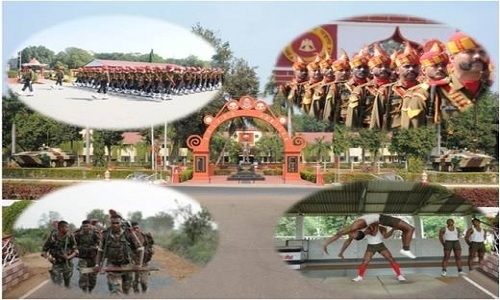Kamptee Cantonment: 200+ years of a model tradition
15 Jan 2023 08:26:19

By Kartik Lokhande
As one travels from Nagpur to Ramtek, through somewhat cluttered municipal town of Kamptee, sight of Kamptee Cantonment soothes eyes. The cantonment comes across as an oasis, with neatly maintained external and internal amenities. This, is the story of evolution of Kamptee Cantonment in its history of more than 200 years.
Nagpur has always been a major military centre. There are several important military establishments in Nagpur even now. One establishment that has survived the test of time and has evolved from garrison to a model cantonment is Kamptee Cantonment. Interestingly, though its beginning as camp completed 200 years in 2021, it now completes 200 years since it developed into a full-fledged cantonment.
As per the records, in 1821, a contingent of 14,000 British and Indian Army personnel along with a Camel Corps, Cavalry, and Artillery moved in from Secunderabad under the command of a Brigadier General. They camped on the Southern bank of Kanhan river and the Kamptee Cantonment began to take shape. They had come to contain and crush the power of the Peshwas, who ruled territory from Pune to Bombay.
However, it was still a camp in 1821. It was 200 years ago, in 1823, that the Bhonsales gifted to the British three nearby villages namely Yerkheda, Desada, and Wadholi, apart from some land along Kanhan river. With this began the fast-paced development. Soon, Kamptee developed into a full-fledged cantonment. Many well-known British and Indian regiments have been stationed here from time to time.
‘The Hitavada’ tried to get official history from the official sources in the past over one year. However, since there was no response to the request, ‘The Hitavada’ went through the records available in different archives and old official accounts.
As per the records, prior to 1821, there were no habitations except one or two hamlets on the bank of Kanhan river. But, the villages of Aajni, Waregaon (Wurregaon), and Yerkheda were in existence. “Practically, the whole of the area of the cantonment is made up of land acquired from these villages. The cantonment originally had an area of about 2,065.262 hectares (5,103.25 acres), but in 1927 it was reduced to 567.37 hectares (1,042 acres) when the new municipality of Kamptee was formed,” state the old records.
The old gazetteer of Nagpur district describes Kamptee Cantonment in beautiful words: “The cantonment has one broad and handsome road called Mall, extending from one end of the railway station to the other. This road is rendered agreeable and cheerful by its avenue of splendid trees. Both the sides of this road are flanked by privately owned bungalows. There are three civil areas in the cantonment viz. the New Godown area to the extreme north-west, Gora Bazar in the centre, and Cavalry Bazar to the south-east. The houses in these areas are mud-built and present a poor appearance. Now, with time, much has changed.” The Sadar Bazar, as described in the old Gazetteer, now forms the Kamptee municipal town.
The old Central Provinces District Gazetteer for Nagpur (Volume A, 1908) offers a peek into the evolution of the Kamptee Cantonment over the years. It states that the cantonment ceased to belong to the Madras Presidency and came under the jurisdiction of the Commander-in-Chief of the Bombay Army, in 1888. The garrison consisted of a Battery of Artillery, one Regiment of British Infantry, one-and-a-half Regiment of Native Infantry, and one Regiment of Native Cavalry in 1889. Two years later, the Regiment of Native Cavalry was removed from Kamptee and the same year the extra half battalion of Native Infantry was transferred to Sambalpur.
The said record reveals that in January 1905, orders were issued under Lord Kitchener’s ‘reorganisation scheme’ for ‘eventual abandonment of Kamptee as a military station’. By that time, the military district of Nagpur had ‘ceased to be of much importance’, as its outlying stations of Raipur and Sambalpur had been ‘denuded of troops’. In the month of March the same year, the staff of Nagpur district was transferred to Ahmednagar. Since then, Kamptee was commanded by the senior Combatant Officer in the station assisted by a fourth-class station staff officer. The cantonment came under the General Officer Commanding the 5th Mhow Division. Two years later, it formed a part of Jubbulpore (present-day Jabalpur) Brigade.
One finds mention in the Central Provinces District Gazetteer for Nagpur (Volume A, 1908) of Kamptee’s importance ‘declining’. Also, the said record of the time mentioned that ‘it may perhaps be abandoned altogether’. At the same time, it acknowledged that for nearly 90 years, Kamptee had been a model cantonment for neatness and cleanliness. In his book ‘An Indian Olio’, General Burton, who was a staff officer in the cantonment from 1858, had appreciated Kamptee Cantonment for presenting ‘a regular and well-ordered appearance beyond that of most other military stations in India’.
At present, Kamptee Cantonment has changed a lot. There is municipal town around. While retaining the old-world charm, Kamptee Cantonment today hosts several prestigious establishments. It has The Brigade of the Guards Regimental Centre, Kamptee Cantonment Board office, NCC Officers’ Training Academy, Army Postal Service Training Centre, well-equipped Military Hospital, a good library, and other establishments. Till early 2021, it hosted the famed Institute of Military Law. Presently, the ‘Agniveer’ recruits are being trained here. Through the winding road of history, Kamptee Cantonment has retained its glory as an important military establishment in Nagpur district.
